Subscribe to EDOM TECH Newsletter
2018/01/30
Standards-Compliant Devices Gear up for Self-Driving Cars
Article by : ROHM Semiconductor
The automotive industry has been rushing straight towards complete autonomous driving. Looking at Japan alone, new cars, including luxury cars as well as general vehicles and minivehicles come equipped with advanced driver assistance systems (ADAS), such as automatic brake system. ADAS has a high degree of recognition and is becoming a common thing. ROHM Co., Ltd. supplies products, mainly power supply LSIs, for ADAS (Fig. 1).
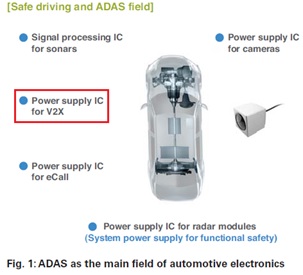
However, in order to achieve complete autonomous driving, various technological innovations are still required. This article describes connected cars, which are important elements of complete autonomous driving, focusing on wireless communication of vehicles.
Looking back on how vehicles were connected to various things using wireless technologies, this article will forecast moves that will happen in the future for this industry. Also, this article will clarify the reasons behind the introduction of functions and current status based on the pursuit for comfort and compliance with regulations.
In-Vehicle Communication
Various wireless functions are incorporated in the cabin space of conventional vehicles.
Smart keys and FM transmitters have been incorporated for the purpose of comfort. In recent vehicle models, wireless local area network (LAN) and Bluetooth have been incorporated in the car navigation and car audio systems, allowing drivers and passengers to enjoy content on the Internet in the vehicle through connection with a smartphone.
Meanwhile, tire pressure monitoring system (TPMS), a function that notifies the driver when tire air pressure drops, has been introduced through regulations in the United States, and has been implemented in Korea and countries in Europe as well, although it is not in the cabin space in the strict sense. It is the first system that combines regulations and wireless communication in the automotive industry.
Initially, the air pressure of four tires was directly monitored, and information was transmitted wirelessly. At present, it can be done through the indirect monitor type, which realizes cost reduction. There is also a system to check the air pressure of tires by checking the balance of the car body. However, this system fails to monitor tire pressure when the pressure of more than one tire is low, and that it requires the car to be moving faster than a certain speed. In particular, it is not possible to monitor tire pressure while the car is parked or stopped, which is a major drawback.
In any case, new cars must have a function to monitor tire pressure in one way or another in the United States, Korea and countries in Europe.
Out-of-Vehicle Communication
Conventional vehicles have incorporated communication functions based on basic reception functions, such as electric toll collection (ETC) system, the Vehicle Information and Communications System (VICS) (Fig. 2), TV, and Global Positioning System (GPS). These functions provided drivers and passengers with comfort in an in-car space.
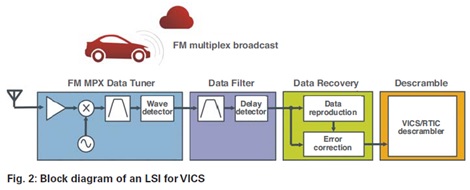
LAPIS Semiconductor Co., Ltd., a ROHM Group company, has been developing LSIs for the ETC system, VICS, and reception of digital TV broadcasts, which have been adopted in the market.
ROHM provides power supply LSIs, general-purpose LSIs, and discrete and passive components necessary for the periphery of those systems, and has contributed to ensure stable operation of those functions.
The connected function has also emerged, which has been introduced to comply with safety regulations. The ERA-Glonass function started in Russia in Jan. 2017, and is also called the Russian version of eCall.
This function is connected to airbags and transmits emergency information and position information to emergency organizations, which correspond to fi re stations in Japan, to shorten the time before the arrival of an ambulance vehicle in the event of an accident. This function is scheduled to be introduced in countries in Europe as well starting April 2018, and its incorporation in new vehicles will become mandatory. This function prevents the occurrence of a second disaster or accidents, in particular, frostbite in cold districts due to the loss of heating in the wake of an accident.
Future Connected
Communication between vehicles and various things, called vehicle to everything (V2X), will become the main theme in the future (Fig. 3). V2X can be said as the vehicle version of Internet of Things (IoT), which has recently become a buzz word.
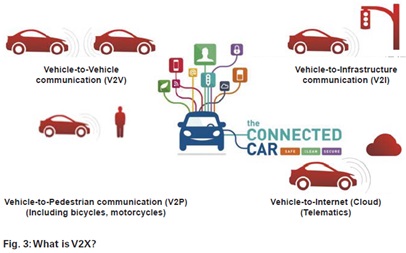
Unprecedented major changes will be gained as a result of the automotive industry and the communications industry working in tandem. Since 10 years ago, the automotive industry and the traffic infrastructure industry have conducted demonstration tests of vehicle-to-vehicle and vehicle-to-infrastructure communications using the communication system called dedicated short range communication (DSRC). V2X is based on this technology.
Initially, various functions to ensure safety were planned to be incorporated with the aim at eradicating traffic-related accidents. As an example of vehicle-to-vehicle communication, drivers perceive from where another vehicle is coming, at an intersection with poor visibility. As an example of vehicle-to-infrastructure communication, traffic signals are being transferred to the drivers and urge them to decelerate.
The industries also created a communication standard called IEEE802.11p exclusively for DSRC so that a single standard can be used commonly worldwide. It is based on wireless LAN (Wi-Fi).
Originally, it was planned to be made into a regulation at the end of 2016 in the United States, and the incorporation of this new standard is to become mandatory in new vehicles.
There are various views on the postponement of the regularization. For one, it was because moves toward autonomous driving was accelerating, and the relations between the communication and autonomous driving were too strong. Another reason is that measures for vulnerability against hacking, which has recently been becoming a problem, are still insufficient.
Certainly, there are many sensors for autonomous driving, including CMOS sensors, and millimeter wave, laser and ultrasound sensors called ADAS. In order to realize complete autonomous driving, as many information sources as possible are needed, and obviously vehicle-to-vehicle and vehicle-to-infrastructure information is one of important information. Also, unless robust measures against hacking of vehicles are realized, it can lead to fatal accidents in complete autonomous driving, which directly connects to the steering system. It can be assumed that V2X could not be started because of these reasons.
The automotive industry pushes ahead toward complete autonomous driving, in which ADAS and artifi cial intelligence (AI) are core technologies. It is considered that information via V2X is necessary for learning for ADAS, in particular, AI.
For example, in a traffic accident, the availability of images immediately before the accident, as well as vehicle-to-infrastructure information between the involved vehicle and the periphery infrastructure from the accident vehicle, and vehicle-tovehicle information and information from ADAS-related devices from the vehicles around the accident zone would help in the dissemination of the accident information to get attention. This information becomes an important information source for AI, on the basis of which measures will be developed, and deployed to all vehicles, leading to safe complete automotive driving.
ROHM provides various power supply LSIs optimal for V2X. The BD9SXXXC Series switching power supply for automotive electronics comes in 2×2mm, 3×3mm, and 4×4m, and supports 0.6 to 6.0A. It is optimal for creating small modules for V2X (Fig. 4).
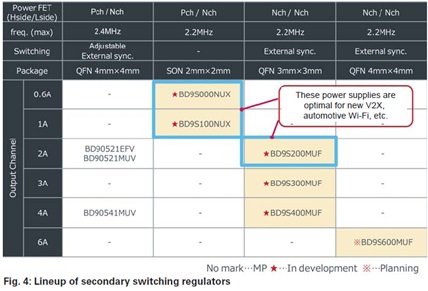
The BD9SXXX-C Series has achieved 2MHz, a switching frequency that accommodates high temperatures (operating temperature of -40 to +125°C) essential for automotive electronics, and is higher than AM band. It enables the scaling down of peripheral components, such as coils and capacitors.
Furthermore, ROHM also provides many low dropout (LDO) regulators that support automotive electronics to accommodate multiple power supplies. In particular, the BUXXJA2MNUX-C Series ultra small LDO regulators, measuring 1×1mm, are optimal for modules to support various power supply configuration requirements (Photo 1).
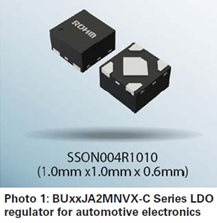
ROHM plans to participate in an organization called 5G Automotive Association (5GAA) in order to make various proposals on power supply LSIs and discrete components for wireless-related products, which are expected to be increasingly introduced in connected cars in the future. 5GAA is the first cross-industry organization established by the communication industry and the automobile industry in order to launch a standard called Cellular-V2X, and deploy it globally. 5GAA was established in Sept. 2016 for the communication industry that pursues the introduction of 5G and the automotive industry that pursues autonomous driving to work together (Fig. 5).
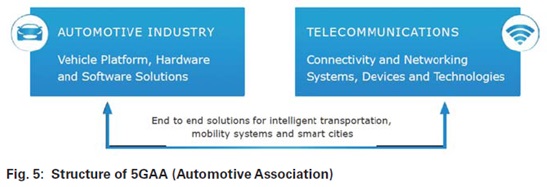
Through participation in 5GAA, ROHM aims to realize three Ecos: Eco Earth, Eco Energy and Eco Life, which the company posts as Creating Shared Value (CSV). Specifically, the company intends to supply compact products and high-efficiency products, which are produced by orchestrating manufacturing and circuit technologies to autonomous driving-related products and products related to 5G communications, which will be produced in mass volume. In order to advance communication functions and autonomous driving, the number of electronic circuits will increase, and further energy-saving and downsizing will be required.
To meet these technological trends, ROHM has developed two power supply prior technologies.
One is Nano Pulse Control, a technology that enables the generation of ultrashort pulse (50nsec or shorter) in switching power supplies. Through significant reduction from about 100nsec of conventional technology, it enables higher frequencies and minimization of coils and capacitors, which make up majority of the power supply section. Thus, the circuit technology realizes the scaling down of products.
The other is Nano Energy, a circuit technology that minimizes circuit current without significantly deteriorating characteristics of power supplies. ROHM intends to realize low power consumption by incorporating this technology in various power supply products and provide high efficiency power supplies with low standby power, leading it to products with short start up time and efficient power consumption.
Although the timing of the introduction of Cellular-V2X has yet to be decided, ROHM intends to advance product development so that it can supply optimum products as speedily as possible, and contribute to the deployment of the standard from the initial stage of its introduction.
The automotive industry has been rushing straight towards complete autonomous driving. Looking at Japan alone, new cars, including luxury cars as well as general vehicles and minivehicles come equipped with advanced driver assistance systems (ADAS), such as automatic brake system. ADAS has a high degree of recognition and is becoming a common thing. ROHM Co., Ltd. supplies products, mainly power supply LSIs, for ADAS (Fig. 1).

However, in order to achieve complete autonomous driving, various technological innovations are still required. This article describes connected cars, which are important elements of complete autonomous driving, focusing on wireless communication of vehicles.
Looking back on how vehicles were connected to various things using wireless technologies, this article will forecast moves that will happen in the future for this industry. Also, this article will clarify the reasons behind the introduction of functions and current status based on the pursuit for comfort and compliance with regulations.
In-Vehicle Communication
Various wireless functions are incorporated in the cabin space of conventional vehicles.
Smart keys and FM transmitters have been incorporated for the purpose of comfort. In recent vehicle models, wireless local area network (LAN) and Bluetooth have been incorporated in the car navigation and car audio systems, allowing drivers and passengers to enjoy content on the Internet in the vehicle through connection with a smartphone.
Meanwhile, tire pressure monitoring system (TPMS), a function that notifies the driver when tire air pressure drops, has been introduced through regulations in the United States, and has been implemented in Korea and countries in Europe as well, although it is not in the cabin space in the strict sense. It is the first system that combines regulations and wireless communication in the automotive industry.
Initially, the air pressure of four tires was directly monitored, and information was transmitted wirelessly. At present, it can be done through the indirect monitor type, which realizes cost reduction. There is also a system to check the air pressure of tires by checking the balance of the car body. However, this system fails to monitor tire pressure when the pressure of more than one tire is low, and that it requires the car to be moving faster than a certain speed. In particular, it is not possible to monitor tire pressure while the car is parked or stopped, which is a major drawback.
In any case, new cars must have a function to monitor tire pressure in one way or another in the United States, Korea and countries in Europe.
Out-of-Vehicle Communication
Conventional vehicles have incorporated communication functions based on basic reception functions, such as electric toll collection (ETC) system, the Vehicle Information and Communications System (VICS) (Fig. 2), TV, and Global Positioning System (GPS). These functions provided drivers and passengers with comfort in an in-car space.

LAPIS Semiconductor Co., Ltd., a ROHM Group company, has been developing LSIs for the ETC system, VICS, and reception of digital TV broadcasts, which have been adopted in the market.
ROHM provides power supply LSIs, general-purpose LSIs, and discrete and passive components necessary for the periphery of those systems, and has contributed to ensure stable operation of those functions.
The connected function has also emerged, which has been introduced to comply with safety regulations. The ERA-Glonass function started in Russia in Jan. 2017, and is also called the Russian version of eCall.
This function is connected to airbags and transmits emergency information and position information to emergency organizations, which correspond to fi re stations in Japan, to shorten the time before the arrival of an ambulance vehicle in the event of an accident. This function is scheduled to be introduced in countries in Europe as well starting April 2018, and its incorporation in new vehicles will become mandatory. This function prevents the occurrence of a second disaster or accidents, in particular, frostbite in cold districts due to the loss of heating in the wake of an accident.
Future Connected
Communication between vehicles and various things, called vehicle to everything (V2X), will become the main theme in the future (Fig. 3). V2X can be said as the vehicle version of Internet of Things (IoT), which has recently become a buzz word.

Unprecedented major changes will be gained as a result of the automotive industry and the communications industry working in tandem. Since 10 years ago, the automotive industry and the traffic infrastructure industry have conducted demonstration tests of vehicle-to-vehicle and vehicle-to-infrastructure communications using the communication system called dedicated short range communication (DSRC). V2X is based on this technology.
Initially, various functions to ensure safety were planned to be incorporated with the aim at eradicating traffic-related accidents. As an example of vehicle-to-vehicle communication, drivers perceive from where another vehicle is coming, at an intersection with poor visibility. As an example of vehicle-to-infrastructure communication, traffic signals are being transferred to the drivers and urge them to decelerate.
The industries also created a communication standard called IEEE802.11p exclusively for DSRC so that a single standard can be used commonly worldwide. It is based on wireless LAN (Wi-Fi).
Originally, it was planned to be made into a regulation at the end of 2016 in the United States, and the incorporation of this new standard is to become mandatory in new vehicles.
There are various views on the postponement of the regularization. For one, it was because moves toward autonomous driving was accelerating, and the relations between the communication and autonomous driving were too strong. Another reason is that measures for vulnerability against hacking, which has recently been becoming a problem, are still insufficient.
Certainly, there are many sensors for autonomous driving, including CMOS sensors, and millimeter wave, laser and ultrasound sensors called ADAS. In order to realize complete autonomous driving, as many information sources as possible are needed, and obviously vehicle-to-vehicle and vehicle-to-infrastructure information is one of important information. Also, unless robust measures against hacking of vehicles are realized, it can lead to fatal accidents in complete autonomous driving, which directly connects to the steering system. It can be assumed that V2X could not be started because of these reasons.
The automotive industry pushes ahead toward complete autonomous driving, in which ADAS and artifi cial intelligence (AI) are core technologies. It is considered that information via V2X is necessary for learning for ADAS, in particular, AI.
For example, in a traffic accident, the availability of images immediately before the accident, as well as vehicle-to-infrastructure information between the involved vehicle and the periphery infrastructure from the accident vehicle, and vehicle-tovehicle information and information from ADAS-related devices from the vehicles around the accident zone would help in the dissemination of the accident information to get attention. This information becomes an important information source for AI, on the basis of which measures will be developed, and deployed to all vehicles, leading to safe complete automotive driving.
ROHM provides various power supply LSIs optimal for V2X. The BD9SXXXC Series switching power supply for automotive electronics comes in 2×2mm, 3×3mm, and 4×4m, and supports 0.6 to 6.0A. It is optimal for creating small modules for V2X (Fig. 4).

The BD9SXXX-C Series has achieved 2MHz, a switching frequency that accommodates high temperatures (operating temperature of -40 to +125°C) essential for automotive electronics, and is higher than AM band. It enables the scaling down of peripheral components, such as coils and capacitors.
Furthermore, ROHM also provides many low dropout (LDO) regulators that support automotive electronics to accommodate multiple power supplies. In particular, the BUXXJA2MNUX-C Series ultra small LDO regulators, measuring 1×1mm, are optimal for modules to support various power supply configuration requirements (Photo 1).

ROHM plans to participate in an organization called 5G Automotive Association (5GAA) in order to make various proposals on power supply LSIs and discrete components for wireless-related products, which are expected to be increasingly introduced in connected cars in the future. 5GAA is the first cross-industry organization established by the communication industry and the automobile industry in order to launch a standard called Cellular-V2X, and deploy it globally. 5GAA was established in Sept. 2016 for the communication industry that pursues the introduction of 5G and the automotive industry that pursues autonomous driving to work together (Fig. 5).

Through participation in 5GAA, ROHM aims to realize three Ecos: Eco Earth, Eco Energy and Eco Life, which the company posts as Creating Shared Value (CSV). Specifically, the company intends to supply compact products and high-efficiency products, which are produced by orchestrating manufacturing and circuit technologies to autonomous driving-related products and products related to 5G communications, which will be produced in mass volume. In order to advance communication functions and autonomous driving, the number of electronic circuits will increase, and further energy-saving and downsizing will be required.
To meet these technological trends, ROHM has developed two power supply prior technologies.
One is Nano Pulse Control, a technology that enables the generation of ultrashort pulse (50nsec or shorter) in switching power supplies. Through significant reduction from about 100nsec of conventional technology, it enables higher frequencies and minimization of coils and capacitors, which make up majority of the power supply section. Thus, the circuit technology realizes the scaling down of products.
The other is Nano Energy, a circuit technology that minimizes circuit current without significantly deteriorating characteristics of power supplies. ROHM intends to realize low power consumption by incorporating this technology in various power supply products and provide high efficiency power supplies with low standby power, leading it to products with short start up time and efficient power consumption.
Although the timing of the introduction of Cellular-V2X has yet to be decided, ROHM intends to advance product development so that it can supply optimum products as speedily as possible, and contribute to the deployment of the standard from the initial stage of its introduction.






